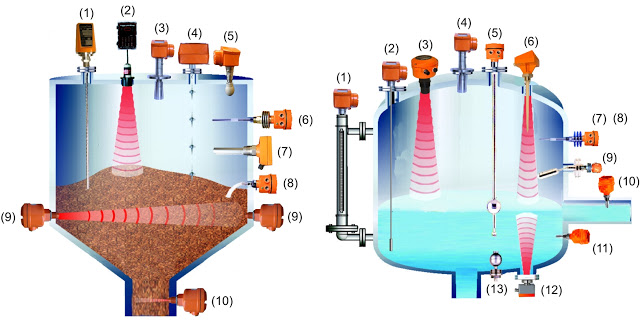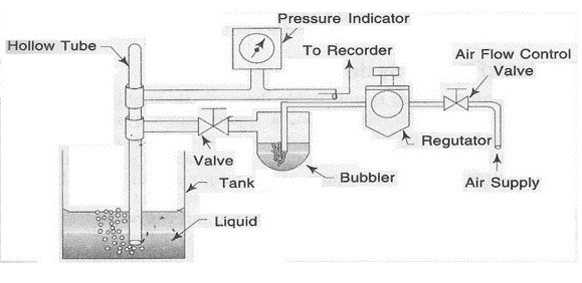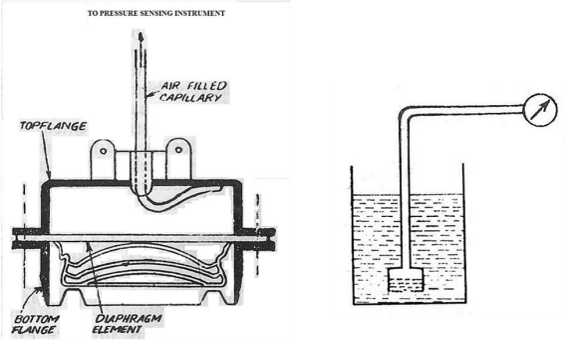In modern manufacturing industries which use many solvents, chemicals, steam and other liquids and in power plants which use vast amount of water, the accurate measurement of liquid level is very essential.
LIQUID LEVEL MEASUREMENT
Generally, there are two methods used in industries for measuring liquid level.
These are
- Direct Method
- Indirect Method
• Direct method use the varying level of the liquid as a mean of obtaining the measurement and the indirect method use a variable that changes with the liquid level to accurate the measuring mechanism.
1. DIRECT METHOD
This is the simplest method of measuring liquid level. In this method, the level of the liquid is measured directly by means of the following level indicators
i. Sight Glass / Gauge Glass
ii. Float Type / Float - Operated Level Gauges
iii. Torque Tube Displacer / Float Displacement Type Level Gauges
SIGHT GLASS / GAUGE GLASS
Sight glass is used for the continuous indication of liquid level within a tank or vessel. A sight glass instrument consists of a graduated tube of toughened glass which is connected to the interior of the tank at the bottom in which the water level is required.
Fig. 1 Fig. 2
Fig.1 shows a simple sight glass for an open tank in which the liquid level in the sight glass matches the level of liquid in the tank. As the level of liquid in the tank rises and falls, the level in the sight glass also rises and falls accordingly. Thus, by measuring the level in the sight glass, the level of liquid in the tank is measured. In sight glass, it is not necessary to use the same liquid as in the tank. Any other desired liquid also can be used.
Fig.2 shows a high pressure sight glass in which measurement is made by reading the position of the liquid level on the calibrated scale. This type of sight glass in high pressure tanks is used with appropriate safety precautions. The glass tube must have a small inside diameter and a thick wall.
Advantages
-
Direct reading is possible
-
Special designs are available for use up to 316°C and 10000 psi.
-
Glassless designs are available in numerous materials for corrosion resistance.
Disadvantages
-
It is read only where the tank is located, which is not always convenient.
-
Overlapping gauges are needed for long level spans
-
Accuracy and readability depend on the cleanliness of glass and fluid
FLOAT DISPLACEMENT TYPE LEVEL MEASUREMENT
These instruments work on the Archimedes principle according to which a body when placed in a liquid is buoyed up by a force equal to the weight of the displaced liquid, and the apparent change in weight of the body is directly proportional to the level of liquid in which it is placed.
Torque tube is the most commonly used device for this purpose.
The displacer is attached to a torque tube assembly whose rotary motion is used for read out/control.
Otherwise, this instrument is rugged and simple in construction and reliable in operation. With selection of suitable material for float, float cage, and torque tube, it’s possible to use this instrument over a wide range of pressure and for many liquids.
Float Displacement Type Level Measurement
Advantages
-
High accuracy
-
Reliable in clean liquids
-
Can be mounted internally or externally (external mounted unit can be disconnected for maintenance)
-
Adaptable to liquid interface measurement
Disadvantages
-
Limited range, devices exceeding 1.2m in length are bulky and difficult to balance
-
Cost increases appreciably for externally mounted units as pressure ratings increase
-
External units may require stilling chambers
2. INDIRECT METHODS
Following are the indirect methods of liquid level measurement generally used in industries.
-
Hydrostatic pressure type
-
Electrical methods
-
Ultrasonic level sensor
i. HYDROSTATIC PRESSURE TYPE
Hydrostatic pressure methods used for liquid level measurement are listed below.
-
Pressure gauge method
-
Air purge system
-
Diaphragm box type
-
Torque balance type
a. Air purge system
Air purge (bubbler tube) is one of the most popular hydrostatic pressure types of liquid measuring system which is suitable for any liquid as shown in fig.
Advantages
-
Pressure gauge can be placed above or below the tank level and can be kept as far away as 500 ft (12.7m) from the tank with the help of piping.
-
Well - suited for measuring the corrosive/abrasive liquid.
b. DIAPHRAGM BOX METHOD
The diaphragm box liquid level meter is shown in fig. and consist of two flanges in between which is contained a diaphragm element made of rubber or oil resistant synthetic composition.
Advantage
Where it is necessary to prevent contact b/w liquid and diaphragm, the box may be installed in a well outside the tank and the well is communicated to the tank with an impulse piping. The impulse piping and the well are filled with an inert liquid.
Disadvantage
The main disadvantage is that the head developed is not sufficient to meet up the line losses as well as for a satisfactory indication. Hence ranges are quite limited.




